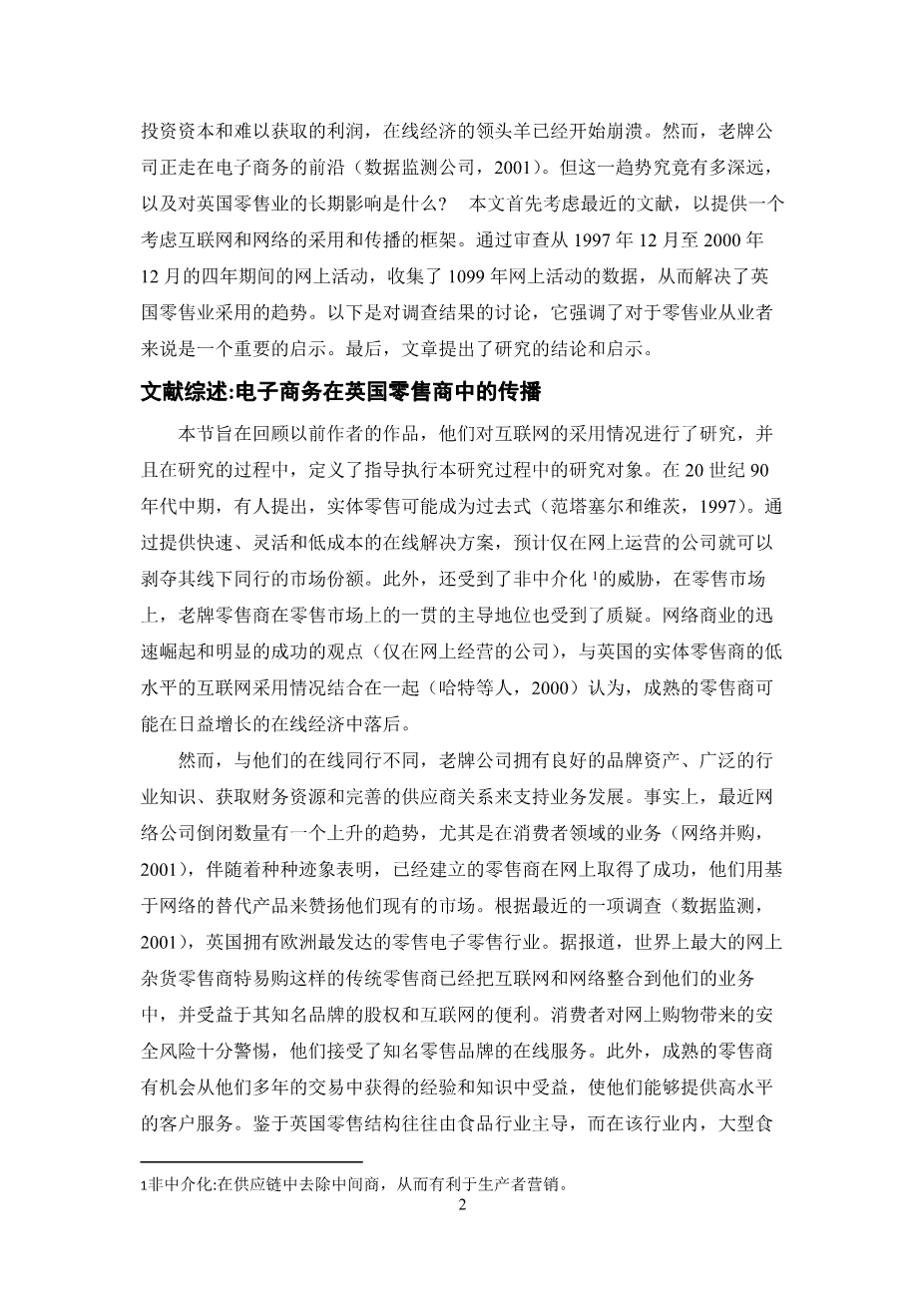Signs of Change? A longitudinal Study of Internet Adoption in
the UK Retail Sector
FIONA ELLIS CHADWICK ,
NEIL DOHERTY and CATHY HART
Key Words: Internet Adoption; Web Retailing; Web-sites; On-line Sales; Retail Sector; United Kingdom.
Abstract: The Internet and the World Wide Web have changed quite significantly in a relatively short period of time. Some of the differences are readily quantifiable or at least easily visible; e.g. exponential growth rates in the number of users, rapid expansion in the number of personal and business web sites, an increase in transmission speeds and the advent of new mark up scripts, such as DHTML. Whilst these quantifiable changes and technological improvements are a valuable benchmark when considering the practical ramifications of developing an on-line business, from a strategic perspective it is perhaps more important to consider the extent to which Internet technologies are likely to effect long-term changes to organisational behavior and economic activity. For instance, in the book retailing business, Internet vendors, benefiting from comparatively low on-line set-up costs, have been able to use price as a major marketing tool. This action has resulted in reduced profit margins across the sector (Mintel, 2000).Therefore, from a retailer’s perspective perhaps the most important issue to resolve is not whether there are sufficient customers on-line but how e-commerce is likely to reshape their markets and business processes. However, little academic research exists which has recorded Internet adoption trends, over time, making assessment of such issues difficult. This paper seeks to redress the balance by presenting a comprehensive and rigorous longitudinal review of the adoption of e-commerce within the UK retail sector. More specifically, the paper provides an up to date assessment of the state of e-commerce within the UK retail sector, before reviewing trends in its adoption over a four-year period form 1997 to 2000. The key finding is that whilst clear evidence of growth has been found across all types of retailers, it is fastest amongst larger retailers, and those operating in sectors such as books, alcoholic beverages and mail order. The paper concludes by offering implications for retail practitioners and for research.
Introduction
During the last four years the World Wide Web has changed. The number of Internet hosts has increased significantly from 19,540,000 in 1997 to 93,047,785 in 2000 (Internet Software Consortium, 2001). The global Internet user community has grown to approximately 179 million (Nua, 2000) and for the first time ever, more women than men will gain access to the Internet (Angus Reid, 2000). The size of the Internet economy has grown ; in 1996 according to Forrester Research (1996) , the total Internet economy was estimated at 15 billion US dollars and by 1999 , revenues from on-line consumer spending alone were estimated at 36 billion US dollars (Boston Consulting Group, 1999). Recently , dot com , companies predicted to lead the on-line economy have begun to collapse, suffering from lack of investment capital and elusive profits. Established companies however are moving to the forefront of e-commerce (Datamonitor, 2001). But how far reaching is this trend and what are the long-term implications for the UK retail sector? This paper initially considers recent literature in order to provide a framework for considering the adoption and diffusion of the Internet and the Web. The trends in adoption in the UK retail sector are addressed by examining data collected from a review of the on-line activities of 1099 over a four-year period from December 1997 to December 2000. A discussion of the findings follows, which highlights key implications for retail practitioners. Finally, conclusions and implications for research are presented.
Literature Review: The Diffusion of E-commerce amongst UK-based Retailers
This section seeks to review the work of previous authors who have conducted studies of the Internet adoption , and in so doing , define the research objectives that guided the execution of this research study. During the mid-1990’s it was suggested that bricks and mortar retailing could become a thing of the past (Van Tassel amp; Weitz, 1997). Companies operating solely on-line were predicted to cannibalise the market share of their off-line counterparts, by offering fast, flexible and lower cost on-line solutions. Moreover, threatened by disintermediation[1], the continued dominance in retail market by established off-line retailers was also brought into question. The rapid rise and apparent success of the dot com business viewed (companies operating solely on-line) in conjunction with the low levels of Internet adoption amongst brick and mortar retailers in the UK (Hart et al, 2000) suggested that established retailers could be falling behind in the growing on-line economy.
However, unlike their on-line counterparts established companies have well-developed brand equity, extensive industry knowledge, access to financial resources and well-developed supplier relationships to support business development. Indeed, a recent rise in the number of dot com company failures, especially in the business to consumer sector (Webmergers, 2001) has been accompanied with indications that established retailers are succeeding on-line, complimenting their existing market offers with web based alternatives. According to a recent survey (Data monitor, 2001), the UK has the most developed grocery e-tailing sector in Europe. Traditional retailers like Tesco, reportedly the world’s largest on-line grocery retailer, have integrated the Internet and the Web into their businesses and benefited from the equity in their established br
剩余内容已隐藏,支付完成后下载完整资料


英语译文共 12 页,剩余内容已隐藏,支付完成后下载完整资料
资料编号:[468478],资料为PDF文档或Word文档,PDF文档可免费转换为Word
以上是毕业论文外文翻译,课题毕业论文、任务书、文献综述、开题报告、程序设计、图纸设计等资料可联系客服协助查找。


